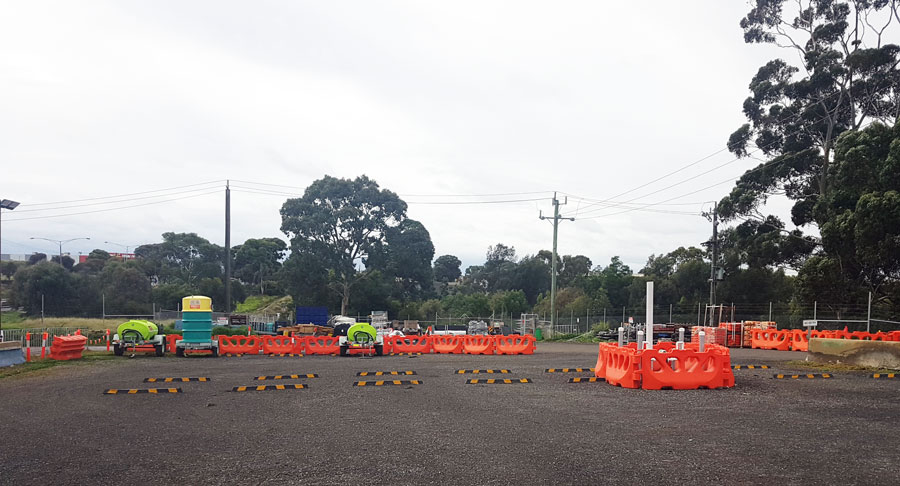How to install wheel stops

Wheel stops are simple yet sturdy bars that can be fixed to asphalt, gravel or concrete surfaces. They are commonly used in car parks to prevent the nose or rear of a car from protruding too far forward when parked.
Jaybro supplies a range of wheel stops for different applications, including concrete and rubber versions. These are often used in carparks, shared areas, commercial and industrial complexes and any other areas that have designated parking zones. Wheel stops also help to protect gardens, fences, exterior walls and pedestrian walkways from cars encroaching into these areas.
An Australian Standard for wheel stops ensures that the product performs reliably when properly installed. Australian Standard AS/NZS 2890.1:2004 states wheel stops must be between 90 - 100mm high with a width of 1650mm. All Jaybro’s wheel stops meet this criteria.
What Type of Wheel Stop do I need?
Depending on your application, Jaybro supplies a choice of concrete, rubber or recycled plastic versions. Each has different advantages and the right choice for you will be based on the area they are being installed (ie: commercial or industrial), what kind of vehicles will frequent the area, and whether it is a high or low volume traffic zone.
Rubber wheel stops are suitable for use on gravel, asphalt, bitumen and other hard surfaces. They do not require concreting or gluing into place and therefore are ready to use immediately after installation. They weigh 14kg and do not require specialist lifting equipment to install. The highly visible yellow and black reflective tape ensures they do not present a tripping hazard for pedestrians. They measure 160mm wide x 100mm high x 1650mm long.
Concrete wheel stops are more durable and suitable for heavy duty use. They weigh 62kg and therefore require lifting slings to position them in place. Concrete stops have two fixing points and can be installed with either galvanized screwbolts or a combination of fixing pins and strong adhesive, all available separately from Jaybro. These wheel stops measure 190mm wide x 100mm high x 1650mm long.
Recycled plastic wheel stops are a tough, lightweight and environmentally friendly option. They weigh 10kg and have three fixing points. They can be installed easily and safely by one person. These carpark wheel stops measure 135mm wide x 95mm high x 1650mm long.
How to install wheel stops
We’re often asked how to install wheel stops, so we have put together this simple guide.
How to install rubber wheel stops
Tools required:
- Your new rubber wheel stop
- Relevant PPE as per your local workplace health and safety recommendations
- For a concrete surface:
- Hammer drill with a 12mm masonry bit and 16mm socket
- 3 x galvanized hex head screwbolts measuring 12mm diameter x 150mm long (Code 36-100047 available from Jaybro)
- For a gravel or asphalt surface:
- Hammer
- 3 x fixing pins measuring 13mm diameter x 360mm long with a 20mm head (Code 82-WSFIX available from Jaybro)
- (Optional) An epoxy such as Megapoxy 36 Gun Grade (Code 40-MP36-600ML available from Jaybro) fitted into a caulking gun.
Install your wheel stop:
- Ensure the surface is flat. Estimate the necessary distance that the wheel stop needs to sit from the kerb, wall or edge. Take into account whether the parking area is designated as front to kerb or rear to kerb as this will affect the installation position.
- Lay the wheel stop in position.
- For a concrete surface, drill a 12mm guide hole through the wheel stop and into the road surface to a depth of approximately 100mm. Brush away any concrete dust.
- Secure the screw bolts through the wheel stop into the pre-drilled holes using your 16mm socket.
- For a gravel or asphalt surface, gun a generous bead of epoxy (if necessary) into the hole.
- Line up the fixing pins and hammer them through the wheel stop and into the road surface.
How to install concrete wheel stops
Tools required:
- Your new concrete wheel stop
- Relevant PPE as per your local workplace health and safety recommendations
- For a concrete surface:
- Hammer drill with a 12mm masonry bit and 16mm socket
- 2 x galvanized hex head screwbolts measuring 12mm diameter x 150mm long (Code 36-100047 available from Jaybro)
- For a gravel or asphalt surface:
- 2 x fixing pins measuring 13mm diameter x 360mm long with a 20mm head (Code 82-WSFIX available from Jaybro)
- An epoxy such as Megapoxy 36 Gun Grade (Code 40-MP36-600ML available from Jaybro) fitted into a caulking gun.
Install your wheel stop:
- Estimate the necessary distance that the wheel stop needs to sit from the kerb, wall or edge. Take into account whether the parking area is designated as front to kerb or rear to kerb as this will affect the installation position.
- Using lifting slings, position the wheel stop into place, ensuring the surface is flat.
- For a concrete surface, drill a 12mm guide hole through the wheel stop and into the road surface to a depth of approximately 100mm. Brush away any concrete dust.
- Secure the screwbolts through the wheel stop into the pre-drilled holes using your 16mm socket.
- For asphalt or gravel surfaces, gun a generous bead of epoxy into the hole. Hammer the fixing pins through the wheel stop and into the road surface.
Need a hand?
Contact the friendly team at Jaybro for further guidance and advice on how to install wheel stops.
 Sign In
Sign In 

